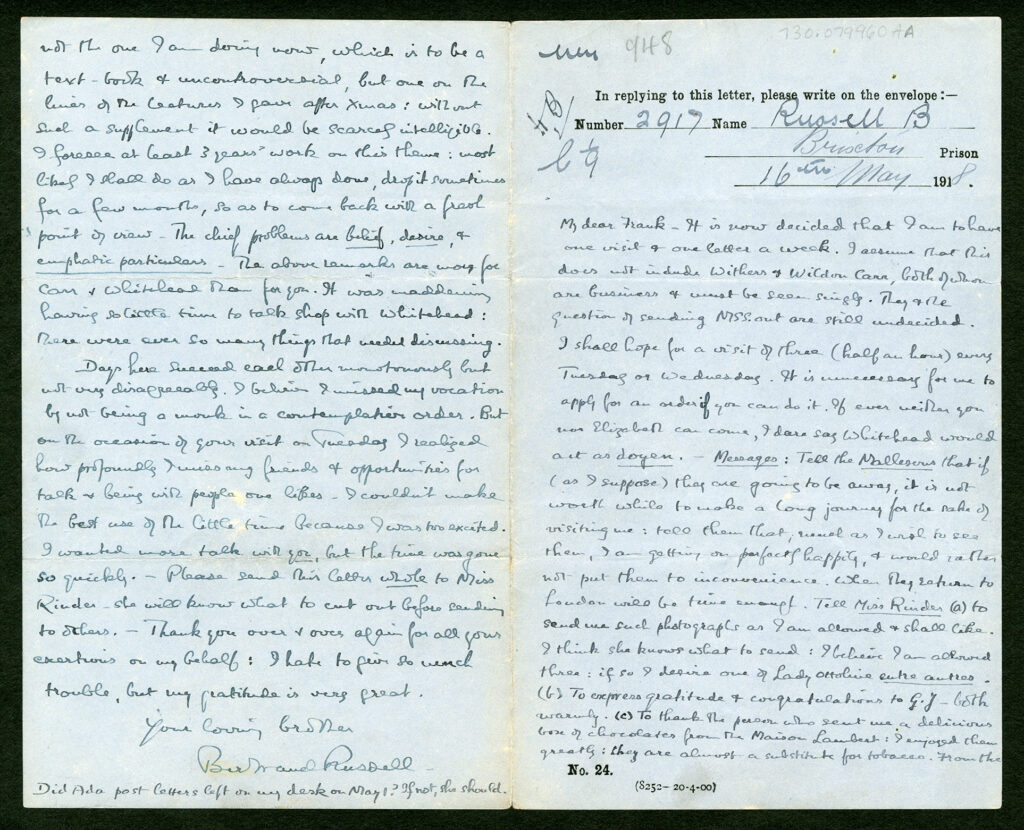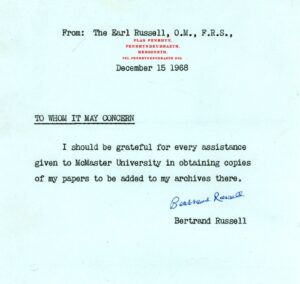
Overview and Project Details
Bertrand Russell was one of the twentieth century’s great letter writers. To preserve and share his thousands of letters, the Bertrand Russell Research Centre hopes eventually to transcribe and annotate them all and to display this content with digitized images of the original documents in a critical online edition, The Collected Letters of Bertrand Russell.
“Any man who comes across letters which he wrote many years ago can verify the manner in which his memory has falsified past events.” – Bertrand Russell, An Outline of Philosophy, Chapter I
Russell the Letter Writer
Russell was one of the twentieth century’s great letter writers. The range of his interests, his multifarious involvement with the world’s affairs, his ceaselessly perceptive intelligence, and his apparently effortless ability to translate his thoughts and feelings into words make his letters a continual source of delight and interest. He wrote to people in all walks of life and on every topic under the sun. There are many important letters about his work and many interesting political letters, including dozens to world leaders. The letters are a hugely important resource for philosophers and historians and for those interested in almost any aspect of twentieth century culture and politics.
Providing contemporary, documentary evidence of what really happened is one important value of letters. As Russell himself wrote in An Outline of Philosophy (Chap. 1): “Any man who comes across letters which he wrote many years ago can verify the manner in which his memory has falsified past events.” Russell devoted some part of each day to letter writing and even in his nineties was dictating twenty or more letters at a sitting. Rather than a burden, Russell’s daily post provided him with the excitement of a ready audience before whom he could express his opinions on a host of topics on which he did not necessarily write professionally.
 The Russell Archives now houses between forty and fifty thousand of his letters and new ones are acquired every year. But he rarely kept copies of his replies until his fourth marriage (in 1952). Thus almost every letter saved by the recipient, discovered, reported in the Russell journal and added to our catalogue, BRACERS, increases our knowledge of Russell’s views on the world or events in his personal life. There may still be many hundreds, if not thousands, of Russell’s letters awaiting discovery. They may be in private hands, already for sale, or in institutions. Their existence may, or may not, be known to some of their owners. Sometimes letters can be located by diligent searching of repositories, whether in person, by mail, or on the Internet. Sometimes letters are offered for sale, and catalogues must be scrutinized. It is thus important that as many as possible of Russell’s extant letters be located, obtained for the Archives and, eventually, incorporated in his Collected Letters. Indeed, Russell himself encouraged this ongoing process of acquisition, in another letter, of course, written shortly after McMaster purchased his archives in 1968, when copyright in all his unpublished writings (regardless of location) was also transferred to the university.
The Russell Archives now houses between forty and fifty thousand of his letters and new ones are acquired every year. But he rarely kept copies of his replies until his fourth marriage (in 1952). Thus almost every letter saved by the recipient, discovered, reported in the Russell journal and added to our catalogue, BRACERS, increases our knowledge of Russell’s views on the world or events in his personal life. There may still be many hundreds, if not thousands, of Russell’s letters awaiting discovery. They may be in private hands, already for sale, or in institutions. Their existence may, or may not, be known to some of their owners. Sometimes letters can be located by diligent searching of repositories, whether in person, by mail, or on the Internet. Sometimes letters are offered for sale, and catalogues must be scrutinized. It is thus important that as many as possible of Russell’s extant letters be located, obtained for the Archives and, eventually, incorporated in his Collected Letters. Indeed, Russell himself encouraged this ongoing process of acquisition, in another letter, of course, written shortly after McMaster purchased his archives in 1968, when copyright in all his unpublished writings (regardless of location) was also transferred to the university.
Project History
A complete print edition of such an immense body of work is out of the question, but digital technology makes an on-line electronic edition feasible. Progress towards this goal was started during the early 2000s under the direction of Nicholas Griffin, when several thousand draft transcriptions of Russell’s letters were prepared using some inventive custom software developed by James Chartrand. (For the curious, a detailed record of these preliminary efforts can be viewed here.) The first step involved capturing more than 100,000 digitized images from microfilm “back-up” copies of the first Russell Archives (RA 1). These images included manuscript material and incoming correspondence as well as letters from Russell—with which the Collected Letters project is primarily concerned. By an ingenious, semi-automated process (using the document numbers stamped on each frame of microfilm) most of the letter images were linked to their metadata in BRACERS. This catalogue of Russell’s correspondence (now totalling 135,500 records) was started in 1992 and underwent a major overhaul in 2014, when the database was migrated from the University Library’s mainframe computer.
When the project was conceived, the images of the letters were to have complemented the transcriptions and supporting scholarly apparatus—annotations to persons, places and events mentioned by Russell, for example, expanded bibliographical references, and commentary on problematic aspects of a letter’s text. But it became apparent that the microfilm source of the digital images—black and white and sometimes of poor quality—was well below the minimum standard required of a modern digital edition. Since the software itself would also require constant upgrading and development, it seemed that a more obvious technical solution was for BRACERS itself to become the foundation of a Collected Letters. BRACERS was already an indispensable tool for research in the Russell Archives and will continue to be maintained and enhanced for that purpose by the University Library.
This change of direction was signalled by The Brixton Letters, which was launched as a pilot project both for developing editorial standards and procedures and building a “front-end” website for additions to the Collected Letters. Although the Collected Letters (in its original guise) had stalled, this more modest but still taxing scholarly edition of Russell’s prison correspondence was designed and implemented very rapidly. This was necessary in order to salute the centenary of Russell’s imprisonment in 1918 and to follow the timetable of his Brixton letter-writing (each letter was published online exactly 100 years to the day after the fact).
Current and Future Work
The Brixton site has a “stand-alone” quality, but its editors—Blackwell, Bone, Griffin and Turcon—hope that it can be a model of sorts, ultimately, for a comprehensive digital edition of Russell’s letters. Its “General Annotations” feature is something that should be implemented more widely as growing numbers of newer transcriptions become fully annotated. This will circumvent the need for repetition of the same biographical annotations in many different transcriptions. A consolidated view of all the General Annotations created for the Brixton Letters can be viewed here. A set of editorial rules, also anticipating textual problems and scenarios not encountered in the prison correspondence, is embedded in the Brixton site. At present the four editors of the Brixton letters will review transcriptions and any new scholarly content in advance of publication online. Some formidable technical challenges remain. Content on the Brixton site did not “sync” seamlessly from BRACERS, where it was initially input and edited. Thus, all late revisions—and there were many and can continue to be made—involved correcting the letters’ transcriptions and their annotations in two separate databases. This drawback was just about manageable for 105 letters but badly needs to be corrected if the Collected Letters is to progress. The obvious solution is to avoid the creation and maintenance of a database separate from BRACERS and to make the Collected Letters fully integrated with this crucial repository of information about the Russell Archives. And there is every reason to believe that, by future enhancements to BRACERS, a robust Collected Letters solution will emerge from this process.
Since completion of the Brixton project, draft transcriptions of over 14,000 more Russell letters have been imported into a currently hidden transcription field in BRACERS. Many were copied from the original Collected Letters database, others from previously published sources, and the entire corpus of Russell’s letters to Lady Ottoline Morrell (over 1,500) and Lady Constance Malleson from their own transcription sets—the latter prepared by Sheila Turcon, who has also annotated much of the “Colette” correspondence. This material is searchable but, given the provisional state of the editorial work, not yet publicly accessible, either through BRACERS or a “Brixton”-like front end for the database. There are a growing number of exceptions, however, including this important, fully edited letter showing, among other things, the challenges of type-setting Russell’s logic. The textual editing guidelines for the Brixton letters have been incorporated in many of the imported transcriptions. Very few, however, have been proofread against the original images, and even fewer of those images have been captured and paired with the transcriptions, as on the Brixton site—although BRACERS, with its dedicated image field, is certainly adaptable for that purpose.
Ideally, the textual authority of transcriptions should be verified before digital publication. But given the rapidly expanding corpus of texts, it make sense for wider access to draft or “non-proofread” transcriptions to be granted. It is both unlikely and undesirable to defer digital publication of a letter pending completion of the scholarly work needed to make an edited Russell letter a worthy addition to the Collected Letters corpus. But fully annotated and accurate letter texts, supplemented by high quality digital images of original documents, is the ultimate goal of the Collected Letters project. Realistically, the forging of a bona fide scholarly edition of all Russell’s correspondence will take decades and require editorial input from many scholars. One possible approach to future work would be to proceed incrementally with more “Brixton”-scale endeavours dedicated to discrete and manageable selections of Russell letters—with individual correspondents most obviously, but also those devoted to particular topics—political, philosophical or personal.
Editorial Rules
The editing and presentation of Russell’s letters will be governed by the following set of editorial rules.
The Brixton Letters
To mark the 100th anniversary of Bertrand Russell’s imprisonment in Brixton Prison in 1918, the Bertrand Russell Research Centre has compiled and transcribed his complete correspondence from the beginning of his stay in prison to its end. Each letter was released exactly 100 years after the letter was written. The release of these 104 letters began on May 2nd and ended on September 13th, 2018, and was followed by the single letter he wrote during his 1961 imprisonment.
His 104 letters from this period can be found online through our special collection, The Brixton Letters.
BRACERS
BRACERS is the Bertrand Russell Archives Catalogue Entry and Research System; in short, it is a full and up-to-date list of Russell’s correspondence.
